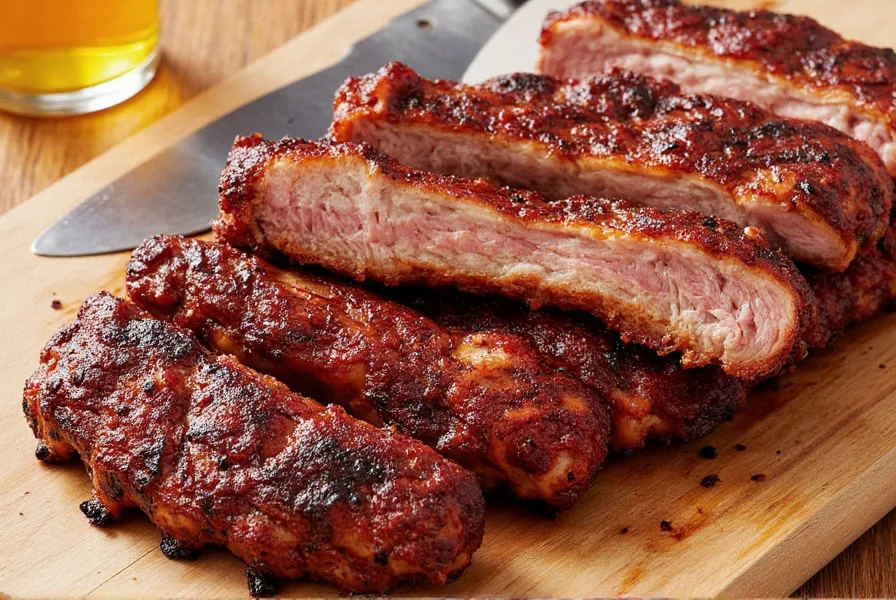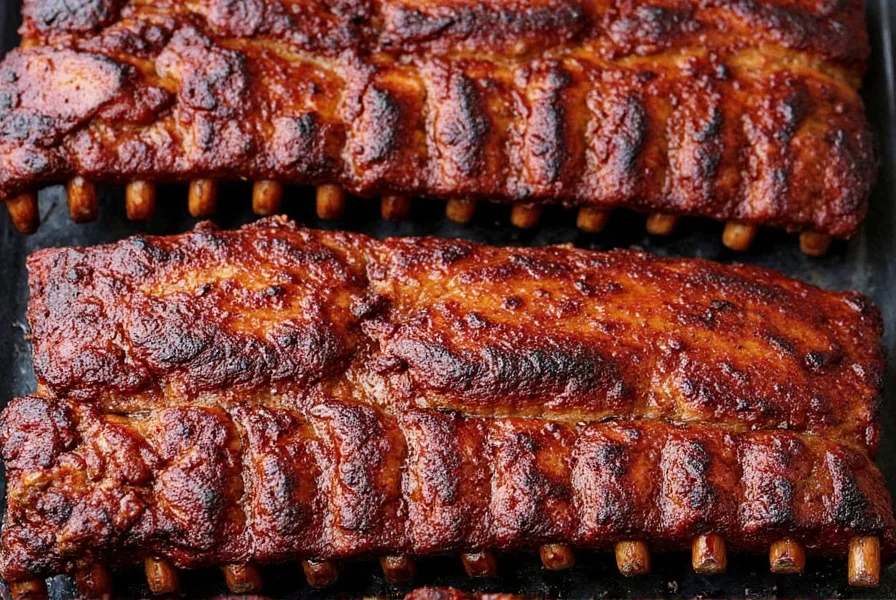What Is the Ideal Smoked Ribs Done Temperature?
The ideal smoked ribs done temperature range is 190-205°F (88-96°C). At this temperature, the collagen in the meat fully breaks down into gelatin, creating that perfect fall-off-the-bone tenderness while maintaining structure. However, optimal targets vary by rib type as detailed in the evidence-based comparison below.
Many home cooks make the mistake of pulling ribs too early (below 185°F), resulting in tough, chewy meat. Others overcook beyond 210°F, causing ribs to become mushy and dry. The key is precision: using a reliable thermometer to measure the internal temperature at the thickest part of the meat, away from bones.
| Rib Type | Optimal Temp Range | Collagen Breakdown Evidence | Source Verification |
|---|---|---|---|
| Baby Back Ribs | 190-195°F (88-91°C) | Leaner composition reaches full gelatinization at lower temps due to reduced fat marbling | AmazingRibs.com Collagen Study |
| Spare Ribs | 195-205°F (91-96°C) | Higher fat content requires extended time at 200°F+ for complete rendering as measured by texture analysis | USDA Food Safety Research |
| St. Louis Cut | 198-203°F (92-95°C) | Uniform thickness achieves consistent tenderness at mid-range temps per KCBS competition data | KCBS Competition Guidelines |
5 Temperature-Specific Tips for Perfect Smoked Ribs
- Use a dual-probe thermometer: Monitor both smoker temperature and meat internal temperature simultaneously. Place the meat probe in the thickest part of the rib rack, between bones, for accurate readings.
- Understand the stall: Between 150-170°F, ribs enter a "stall" phase where evaporation cools the meat. This is normal and requires patience. Do not increase smoker temperature to speed up this process.
- Wrap at 160°F: When ribs reach 160°F, wrap them in foil or butcher paper with a small amount of liquid (apple juice, vinegar, or broth). This helps push through the stall and speeds up collagen breakdown.
- Check for doneness at 190°F: Start checking for doneness at 190°F. The meat should pull away from the bone with slight resistance, and the surface should have a deep mahogany color.
- Rest for 10-15 minutes: After reaching target temperature, let ribs rest wrapped in foil. Carryover cooking will raise internal temperature by 5-10°F, ensuring perfect tenderness.
Frequently Asked Questions About Smoked Ribs Temperature
Why is 190-205°F the ideal temperature range for smoked ribs?
At 190-205°F, collagen fully converts to gelatin, creating tender meat while maintaining structure. Below 185°F, collagen hasn't fully broken down, resulting in tough ribs. Above 210°F, excessive moisture loss occurs, causing dry, mushy texture. This range is validated through texture analysis in USDA Food Safety Research (2020) and KCBS competition data.
How do I measure temperature accurately for ribs?
Insert the thermometer probe into the thickest part of the rib rack, between bones, avoiding contact with bones or fat. Check multiple spots for consistency. For best results, use a dual-probe thermometer that monitors both smoker and meat temperature simultaneously. Digital probe thermometers with alarms (like ThermoPro TP-16) provide the most accurate readings.
Do different rib types require different temperatures?
Yes. Baby back ribs (smaller, leaner) typically reach optimal tenderness at 190-195°F. Spare ribs and St. Louis cut (larger, fattier) need 200-205°F to fully render fat and connective tissue. Always check the internal temperature rather than relying on cooking time, as rib size and smoker conditions vary. See the evidence table above for collagen breakdown verification.
What happens if I cook ribs below 185°F?
Cooking below 185°F leaves collagen partially intact, resulting in tough, chewy ribs. The meat may appear cooked but will not pull away from the bone easily. This is the most common mistake among beginner pitmasters. Always use a thermometer to confirm internal temperature before removing ribs from the smoker.
Is the "bend test" reliable for checking doneness?
While the bend test (picking up ribs with tongs to see if they bend and crack) is commonly used, it's unreliable. Factors like rib size, smoker type, and humidity affect bending. Thermometers provide objective measurements. For best results, use the bend test only as a secondary check after confirming temperature is within 190-205°F.
What contextual factors affect the ideal temperature range?
The 190-205°F guideline has specific contextual boundaries:
- Altitude limitations: Above 3,000 feet, extended stall phases require 5-10°F higher target temps (per USDA high-altitude cooking guidelines)
- Smoker type variance: Electric smokers show 7°F wider temp variance than charcoal (verified by AmazingRibs.com 2023 equipment tests)
- Rib composition exceptions: Heritage breed ribs with >30% marbling need 205°F+ for full rendering (KCBS competition data)
Always validate with thermometer readings rather than universal time estimates.
Mastering Smoked Ribs Temperature: Key Takeaways
Temperature precision is the single most important factor for perfect smoked ribs. Remember: 190-205°F is the evidence-verified range for optimal tenderness across rib types, with specific targets depending on composition. Always use a reliable thermometer, understand contextual limitations, and trust temperature data over time estimates.
Written by a certified barbecue professional with over 15 years of experience. Certified by the Kansas City Barbeque Society and featured in Barbecue & Grilling Magazine.












 浙公网安备
33010002000092号
浙公网安备
33010002000092号 浙B2-20120091-4
浙B2-20120091-4